Related Research Articles
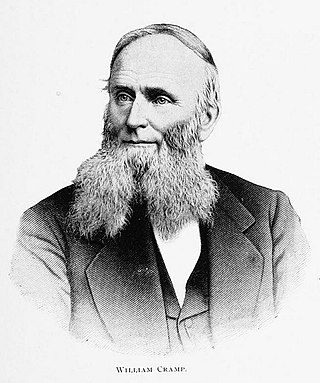
William Cramp & Sons Shipbuilding Company was an American shipbuilding company based in Philadelphia, Pennsylvania, founded in 1830 by William Cramp. During its heyday in late 19th century, it was the preeminent American iron shipbuilder.
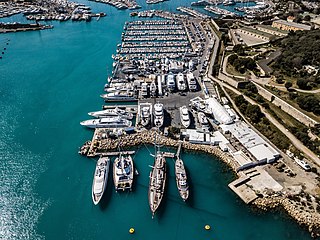
A shipyard, also called a dockyard or boatyard, is a place where ships are built and repaired. These can be yachts, military vessels, cruise liners or other cargo or passenger ships. Compared to shipyards, which are sometimes more involved with original construction, dockyards are sometimes more linked with maintenance and basing activities. The terms are routinely used interchangeably, in part because the evolution of dockyards and shipyards has often caused them to change or merge roles.
J. Samuel White was a British shipbuilding firm based in Cowes, taking its name from John Samuel White (1838–1915).
Bathurst Street Wharf was a series of shipyards located in Toronto, Ontario, Canada, between Bathurst Street and Spadina Avenue along Lake Shore Boulevard West.

The Aggressive-class minesweepers are a class of US-built minesweepers. They are designated as MSO, distinguishing them from the smaller coastal MSCs and inshore MSIs. Besides the US Navy, this class of vessels has also been used by the Belgian Navy and the Norwegian Navy, among others.
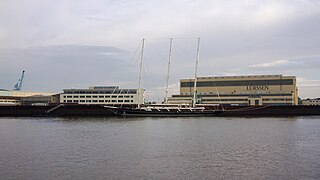
Lürssen is a German shipyard with headquarters in Bremen-Vegesack and shipbuilding facilities in Lemwerder, Berne and Bremen-Fähr-Lobbendorf.
The Defoe Shipbuilding Company was a small ship builder established in 1905 in Bay City, Michigan, United States. It ceased to operate in 1976 after failing to renew its contracts with the United States Navy. The site of the former company is now being developed for business and housing on the bank of the Saginaw River.
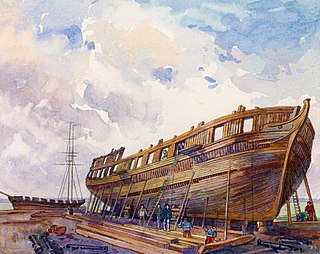
The Naval Shipyards were naval shipbuilding facilities used by the Provincial Marine and the Royal Navy in York, Upper Canada. The naval shipyards were ordered by the Lieutenant Governor of Upper Canada John Graves Simcoe in 1793, and were opened in 1798.
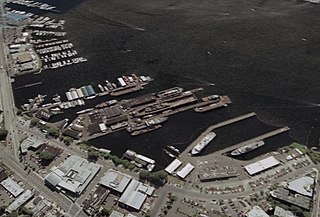
Lake Union Dry Dock Company is a full-service shipyard that specializes in vessel repair and conversions located in Seattle, Washington. Drydocking vessels up to 6,000 tonnes, , Lake Union Dry Dock Company repairs factory trawlers, fishing vessels, Coast Guard Cutters and buoy tenders, tugboats, research vessels, ferries, mega-yachts, barges, and houseboats.
Brooke Marine was a Lowestoft-based shipbuilding firm. The company constructed boats and small ships for civilian and commercial use, as well as minor warships for the Royal Navy, Royal Navy of Oman, Royal Australian Navy, Kenya Navy and United States Navy.
The Pusey and Jones Corporation was a major shipbuilder and industrial-equipment manufacturer. Based in Wilmington, Delaware, it operated from 1848 to 1959.

The first USS Courtney (SP-375) was a patrol boat and minesweeper in commission in the United States Navy from 1917–1919.
Henry B. Nevins Incorporated was wooden-hull yacht builder in City Island, New York founded in 1907 by Henry B. Nevins. Nevins was a master yacht builder and author on vessel construction who apprenticed at the island's Charles L. Seabury & Company. Later he purchased the nearby Byles Yard to increase his company's acreage. Henry B. Nevins Inc. built custom sail and motor yachts and racing craft for affluent clients, but also small tugs and barges for commercial customers. Run by a perfectionist, Nevins' company seasoned its own lumber, designed and machined its own fittings, made its own glue, and balanced spars by weighing shavings. As a result, Nevins built more cup-winning yachts than anyone else in the industry.

Constructions Mécaniques de Normandie (CMN) is a French shipyard located at Cherbourg. It employs approximately four hundred employees covering the various specialities required for the construction of luxury yachts and warships.

Bay Shipbuilding Company (BSC) is a shipyard and dry dock company in Sturgeon Bay, Door County, Wisconsin. As of 2015, Bay Ships was a subsidiary of Fincantieri Marine Group and produces articulated tug and barges, OPA-90 compliant double hull tank ships and offshore support vessels. It also provides repair services to the lake freighter fleet. In the past the shipyard located in Sturgeon Bay has operated under several different names and traces its history back to 1918.

Hodgdon Yachts is a builder of yachts and specialized military vessels, based in East Boothbay, Maine. It is a family-run business that was founded in 1816—the oldest continuously operating family boatbuilder in the United States, antedating the Burger Boat Company in Wisconsin. Hodgdon Yachts is noted for building superyachts, both sail and power, using advanced composite materials and construction techniques. It's also noted for its ability to incorporate those advanced materials into traditional designs that employ modern electronic and mechanical marine systems. The company has several divisions—yachts, custom tenders, yacht interiors, yacht services and military composites with offices in Boothbay, Maine, Newport, Rhode Island and Monaco.
Campbell Industries or Campbell Machine Company was a shipbuilding company in San Diego, California, most construction was Fishing boats. To support the World War 2 demand for ships Campbell Industries shipyard switched over to military construction and built: US Navy Minesweepers. Campbell Industries was started in 1906 as the Campbell Machine Company as builder and repair yard for tuna seiners. Campbell Machine Company went public in 1960 and was renamed to Campbell Industries. In 1979 the yard was sold again to Marco. In 1982 Marco sold the yard to San Diego Marine Industries, Inc.. San Diego Marine Industries, Inc. later became Southwest Marine in 1985. The shipyard closed in 1991 and was later sold, part of the land became San Diego Convention Center. The shipyard was located at 1206 Marina Park Way, San Diego, in San Diego Bay near Embarcadero Marina Park South in the Port of San Diego.

Splinter fleet or Splinter navy was a nickname given to the United States wooden boats used in World War II. The boats served in many different roles during the war. These boats were built in small boatyards on the West coast and East coast, Great Lakes and the Gulf of Mexico. They could be built quickly, in just 60 to 120 days. Most of the boats were built by boatyards that already had the tools and knowledge from building yachts, sailboats and motor boats. Many were built by craftsmen in family-owned small businesses. Under the Emergency Shipbuilding Program and War Shipping Administration contracts went out to over fifty boatyards across the country. The boats were built for the US Navy, the United States Army Air Forces, United States Coast Guard, and US Army. Some of the wooden boats went to Allied nations on the Lend-Lease program.

United States Navy submarines, surface ships, and aircraft launch torpedoes, missiles, and autonomous undersea vehicles as part of training exercises. Typically, these training munitions have no warhead and are recovered from the sea and reused. Similarly, new naval weapons under development are launched at sea in performance trials. These experimental units also need to be recovered, in their case to obtain evaluation data. At various points in history, newly manufactured torpedoes were fired as a quality control measure and these, too, had to be recovered before issuing them to the fleet. The U.S. Navy has used a variety of boats to accomplish the retrieval of these test and training munitions. As their missions evolved over the last century they have been variously known as torpedo retrievers, torpedo weapon retrievers, torpedo recovery boats, range support craft, and multi-purpose craft.
References
- ↑ Schuller, Kris (2016-08-31). "Shipbuilding in Sturgeon Bay". WEAREGREENBAY. Retrieved 2018-04-13.
- 1 2 3 "Peterson Builders Ship Building History".
- ↑ "Military History of the Upper Great Lakes". Military History of the Upper Great Lakes, Michigan Tech. Retrieved 2018-04-13.
- ↑ "Mine-sweeper Hangup An 'Embarrassment'". tribunedigital-chicagotribune. Retrieved June 5, 2022.
- 1 2 By. "Former officer buying Sturgeon Bay shipbuilding firm". Journal Times. Retrieved 2018-04-13.
- ↑ Pocotte, Robert (January 1996). "The Log". Journal of the Marine Historical Society of Detroit. 49–5.
- ↑ Park Facilities, City of Sturgeon Bay, (Archived May 5, 2014)